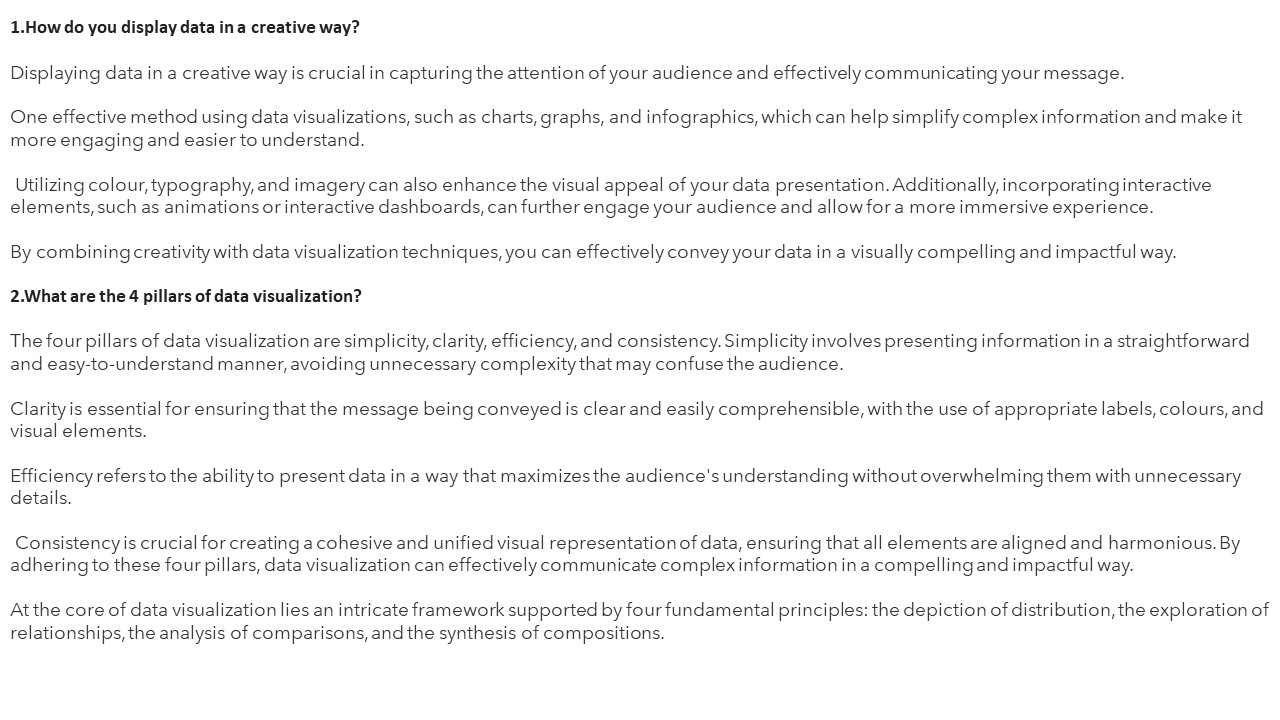Creative Data Visualization Tips for Consulting Decks - PowerPoint PPT Presentation
Title:
Creative Data Visualization Tips for Consulting Decks
Description:
Elevating your consulting decks with 10 creative data visualization ideas can differentiate your work and leave a lasting impression on clients. By incorporating innovative and visually engaging charts, graphs, and infographics, you can effectively convey complex information in a clear and concise manner. – PowerPoint PPT presentation
Number of Views:1
Title: Creative Data Visualization Tips for Consulting Decks
1
1.How do you display data in a creative
way? Displaying data in a creative way is
crucial in capturing the attention of your
audience and effectively communicating your
message. One effective method using data
visualizations, such as charts, graphs, and
infographics, which can help simplify complex
information and make it more engaging and easier
to understand. Utilizing colour, typography,
and imagery can also enhance the visual appeal of
your data presentation. Additionally,
incorporating interactive elements, such as
animations or interactive dashboards, can further
engage your audience and allow for a more
immersive experience. By combining creativity
with data visualization techniques, you can
effectively convey your data in a visually
compelling and impactful way. 2.What are the 4
pillars of data visualization? The four pillars
of data visualization are simplicity, clarity,
efficiency, and consistency. Simplicity involves
presenting information in a straightforward and
easy-to-understand manner, avoiding unnecessary
complexity that may confuse the audience.
Clarity is essential for ensuring that the
message being conveyed is clear and easily
comprehensible, with the use of appropriate
labels, colours, and visual elements.
Efficiency refers to the ability to present
data in a way that maximizes the audience's
understanding without overwhelming them with
unnecessary details. Consistency is crucial for
creating a cohesive and unified visual
representation of data, ensuring that all
elements are aligned and harmonious. By adhering
to these four pillars, data visualization can
effectively communicate complex information in a
compelling and impactful way. At the core of
data visualization lies an intricate framework
supported by four fundamental principles the
depiction of distribution, the exploration of
relationships, the analysis of comparisons, and
the synthesis of compositions.
2
3. How to structure a consulting deck? When
creating a consulting deck, it is crucial to
structure it in a clear and concise manner to
effectively communicate your message to clients.
Start by outlining the key objectives and scope
of the project at the beginning of the deck.
Follow this with a detailed analysis of the
current situation, including any challenges or
opportunities that need to be addressed.
Present your recommendations and proposed
solutions with supporting data and evidence to
build credibility. Use visuals, such as charts
and graphs, to help explain complex information
and make the content more engaging. 4.What are
the 5 C 's of data visualization? There are five
key characteristics that apply universally to all
types of data cleanliness, consistency,
conformance, currency, and comprehensiveness.
These attributes, commonly referred to as the
five Cs of data, are essential considerations
regardless of the size or nature of the data in
question. 5.What are the different techniques of
data visualization? Data visualization is an
essential component of data analysis, allowing
for the clear and concise representation of
complex information. Among the various forms of
data visualization available, some of the most
utilized include bar charts, line charts, scatter
plots, pie charts, and heat maps. Each of these
visualization techniques serves a specific
purpose in conveying data insights effectively.
3
Bar charts are frequently employed to compare
categories of data, while line charts are useful
for displaying trends over time. Scatter plots
are valuable for identifying relationships
between variables, and pie charts are ideal for
showing the distribution of data within a
whole. Heat maps are particularly effective in
visualizing data density or patterns across a
geographic area or matrix. By understanding the
strengths and limitations of these different
visualization methods, data analysts can choose
the most appropriate technique to present their
findings in a way that is easily understood and
impactful.
4
https//visualsculptors.com/ https//visualsculpt
ors.com/our-portfolio/































